



The Sikorsky R-4 Helicopter
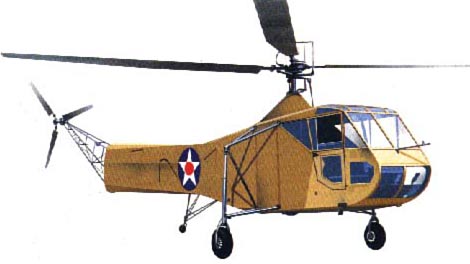
Sikorsky R-4 Helicopter was the first production
helicopter in the world and proved itself in active service in
W.W. II.
Have
you thought about an Igor Sikorsky airplane?
1910 S-2, Igor Sikorsky Flew for the First time
1911 S-5, Igor's First pilot license issued from the Imperial
Aero Club of Russia
1912 S-6A won First place in the Moscow Aircraft Competition,
pilot Igor Sikorsky
1913 S-9 First monocoque fuselage constructed in Russia
1913 S-10 establish a Russian Aviation Record flying 500 kilometers
in 4 hrs and 56 min
1913 S-12 First Russian designed aircraft capable of a loop
1913 S-12 Established a Russian Altitude Record of 3,680m
1913 Igor Sikorsky flew the S-21 "Grand" the World's First
successful four-engine plane.. Cam M
Howzit... Built the R-4 redraw (large), nice and simple but
HUGE! Printed the model on orange card and then selected parts
(windows, insignia, etc.) on white card and combined the two
and a very nice result. Niki
I took away all the mCX-parts not needed to fly, just look to the picture, there is the original mCX ,by e-flite and the stripped R-4 with the electronics beside. The regular-pdf was just as you sent it no changes necessary. Only some holes had to be cut! Thanks for the fun you provide with your models... Best regards Stefan.

 |
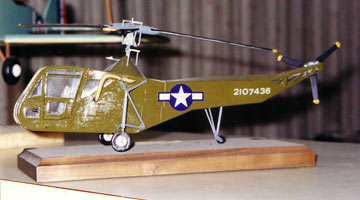 |
|
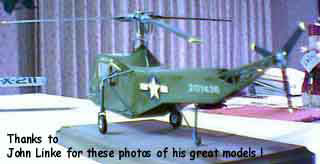 This unique model has highly detailed spinning rotors. |
I turned to Fiddlersgreen
to find exciting fuselages for my electric RC helicopters. I
am very bored with the “pod and
|
|
Sikorsky R-4 Helicopter
On October 31, 1938, a few months after United Aircraft had authorized design work on helicopters, representatives from the Materiel Division visited Sikorsky for the purpose of investigating helicopter development. Nothing resulted from this visit nor from a helicopter development proposal submitted on May 28, 1940, when Igor Sikorsky visited the Materiel Division at Wright Field, Ohio, and showed moving pictures of early VS-300 tests.
 Better luck attended a visit by Materiel Division representatives
to the manufacturer's plant in Stratford, Connecticut, in July
1940 as Captain H Franklin Gregory became the first military pilot
to fly the VS-300. Moreover, on the 19th of that month the War
Department used $3,000 from the Dorsey Bill to purchase engineering
data on the Vought-Sikorsky VS-3II a proposed derivative of the
VS-300. Less than one month later, on August 14, Sikorsky submitted
a proposal to build a VS-316 prototype for $50,000. On August
30, the Chief of the Materiel Division was requested to grant
authority for purchase of this helicopter from unexpended Dorsey
Bill funds.
Better luck attended a visit by Materiel Division representatives
to the manufacturer's plant in Stratford, Connecticut, in July
1940 as Captain H Franklin Gregory became the first military pilot
to fly the VS-300. Moreover, on the 19th of that month the War
Department used $3,000 from the Dorsey Bill to purchase engineering
data on the Vought-Sikorsky VS-3II a proposed derivative of the
VS-300. Less than one month later, on August 14, Sikorsky submitted
a proposal to build a VS-316 prototype for $50,000. On August
30, the Chief of the Materiel Division was requested to grant
authority for purchase of this helicopter from unexpended Dorsey
Bill funds.
While the Air Corps was interested in procuring a Sikorsky helicopter under the provision of the Dorsey Bill, the Judge Advocate General decided that all of the Government agencies interested in this development, not just the Air Corps, had to approve this procurement.
Accordingly, during a meeting held in Washington in December 1940, representatives of various agencies reviewed the Sikorsky proposal to build an observation/training helicopter and, agreeing that its acceptance would be an excellent opportunity to obtain a worthwhile development at a reasonable cost, unanimously recommended that the Air Corps negotiate a contract with Sikorsky for one experimental model.
Inspection of the mock-up of the VS-316 on April 16, 1941, by Frank Gregory, now a Major, resulted in several changes to give better visibility and to make various instruments more accessible to the crew.

At that time, it was estimated that the prototype, which received the military designation XR-4 and the serial 41-18874, would fly in August 1941. However, experience gained during trials with the VS-300 led to a redesign of the tail rotor installation and completion of the XR-4 was delayed while Sikorsky experimented with revised tail rotor installations.
While the XR-4 was being completed to this configuration, further trials with the VS-300 prompted Sikorsky to conclude that the remaining horizontal rotor could also be removed and cyclic control transferred to the main rotor. As this revised configuration proved successful when the experimental helicopter, now designated VS-300A, was returned to flight status on December 8, 1941, the AAF agreed that the XR-4 was to be similarly modified as soon as possible.
Initial trials:
Completed at the end of 1941 and powered by a 175 hp Warner
R-500-3 radial engine driving a three-bladed main rotor, a three-bladed
horizontal tail rotor, and a two-bladed anti-torque rotor, the
XR-4 was first flown by Charles 'Les' Morris at Stratford on January
14, 1942. On that day, six flights were made, the longest of which
lasted just over 7 min. Following some minor modifications, the
designation was changed to VS-316A and the contract price increased
from $40,000 to $50,000.
 With America now in the war and light observation
aircraft ('grasshoppers') about to be included in the TO&E
(Table of Organisation and Equipment) of Army Ground Force units,
the Army Air Forces arranged to evaluate the XR-4 at Wright Field.
After demonstrating at Stratford on April 20, 1941, that it could
fly backwards, climb vertically to 500ft, hover 100ft above the
ground, fly at a top speed of 70kt, and reach an altitude of 5,000ft, the XR-4 flew to Wright Field under its own power, flying
the 761 miles in l6hr 10min without encountering any significant
problems.
With America now in the war and light observation
aircraft ('grasshoppers') about to be included in the TO&E
(Table of Organisation and Equipment) of Army Ground Force units,
the Army Air Forces arranged to evaluate the XR-4 at Wright Field.
After demonstrating at Stratford on April 20, 1941, that it could
fly backwards, climb vertically to 500ft, hover 100ft above the
ground, fly at a top speed of 70kt, and reach an altitude of 5,000ft, the XR-4 flew to Wright Field under its own power, flying
the 761 miles in l6hr 10min without encountering any significant
problems.
The first flight was made on January 14, 1942. Many subsequent
experiments included adding fabric covering to determine what
effect this additional surface would have on the control of the
aircraft. The XR-4's design was simple, featuring tubular construction,
a boxlike cabin with side-by-side seating for a crew of two, and
full dual controls.
Between May 30, 1942, and January 4, 1943, during the flight test program at Wright Field, the XR-4 set six unofficial records by flying at a top speed of 80 mph, reaching an altitude of 9,200ft with a crew of two and 12,000ft with a crew of one, covering a distance of 112 miles and climbing at 770 ft/min at a gross weight of 2,4001b.
Returned to the contractor in January 1943, the XR-4 was modified to YR-4A standard by the installation of a 200hp Warner R-550-1 radial and increasing the main rotor diameter from 36ft to 38ft.
Service testing the YR-4A and YR-4B:
Sikorsky was requested to submit quotations for a service
test batch of 13 YR-4As, plus two to be supplied to Great Britain..
Procurement authority was granted on April 30, 1942, and the 15
YR-4As, were ordered via a letter contract finally approved on
January 15, 1943.

These machines differed from the XR-4 in having the slightly more powerful R-550-I, a main rotor of increased diameter, and fuel tank capacity increased from 25 to 30 US gal. Design gross weight was to be increased from 2,400 to 2,535lb.
Subsequently, the contract was thrice amended, first to add an additional 15 helicopters for the US Navy and the UK, then to have the airframe originally ordered for static test completed as a special test article, and finally, to have Sikorsky complete all but the first three as YR-4Bs with provision for the installation of bomb racks (for three 100lb or one 325 lb bombs) or a litter container on the port side.
Making its first flight on May 3, 1943, the first
YR-4A was flown to Fort Monmouth, New Jersey, for Signal Corps
demonstration and then to Washington, DC, to take part in an air
mail anniversary celebration, and to be demonstrated to President
Roosevelt. In July 1943, after being fitted with low-pressure
rubberized floats, it was used for tests aboard the US Army Transport
James Parker anchored in Long Island Sound.
The first helicopter combat rescue:
 Organized in early.1944 as part of 'Project 9' to provide
air support for Brig Orde Wingate's Long Range Penetration Group
operating behind enemy lines in Burma, the American 5138th Air
Unit was redesignated the First Commando Force and was initially
composed of a fighter section with P-51As, a bomber section with
B-25Hs. a transport section with C-47As, a glider section with
CG-4As and TG-5s, and a liaison section with L-1As, L-5Bs, and
YR-4Bs. Until the Japanese surrender, the 1st ACO operated with
conspicuous success from Hailakandi and Assandol in India and
from forward bases in Burma'.
Organized in early.1944 as part of 'Project 9' to provide
air support for Brig Orde Wingate's Long Range Penetration Group
operating behind enemy lines in Burma, the American 5138th Air
Unit was redesignated the First Commando Force and was initially
composed of a fighter section with P-51As, a bomber section with
B-25Hs. a transport section with C-47As, a glider section with
CG-4As and TG-5s, and a liaison section with L-1As, L-5Bs, and
YR-4Bs. Until the Japanese surrender, the 1st ACO operated with
conspicuous success from Hailakandi and Assandol in India and
from forward bases in Burma'.
The four Sikorsky YR-48s were airlifted to India aboard Curtiss C-46 Commandos, one being destroyed in the crash of a C-46 and a replacement being forwarded immediately. Soon after being reassembled at Hailakandi, two were destroyed in accidents while flown by a pilot who had already survived two crashes in fixed wing aircraft, leaving two for operational evaluation. One of these primitive helicopters, known as Eggbeaters' to the servicemen, was used by Lt Carter Harman to make a daring rescue deep behind enemy lines.
This combat rescue, the first ever made by a helicopter, was undertaken after a Vultee L-1B carrying three wounded British soldiers had come down some 100 miles behind enemy lines in Burma after being hit by ground fire on April 21, 1944. As the closest Allied base was the Aberdeen glider airstrip and with dense jungle and Japanese troops nearby, a ground rescue attempt or the use of fixed-wing rescue aircraft was considered impractical. It was therefore decided to use one of the untried YR-4Bs.
 To conduct the attempt, the two-seat helicopter
was ferried from its base at Lalaghat to a forward base at Taro
and on to Aberdeen along a circuitous 500-mile route, most of
which was over Japanese occupied territory. Refueling stops were
made every 100 miles or so at locations controlled by Wingate's
raiders. Finally, on April 25, three days after the L-1B had been
forced down, Lt Harman flew his YR-4B from Aberdeen to a clearing
near the crash site, a distance of approximately 60 miles, and
picked up the first of the British wounded.
To conduct the attempt, the two-seat helicopter
was ferried from its base at Lalaghat to a forward base at Taro
and on to Aberdeen along a circuitous 500-mile route, most of
which was over Japanese occupied territory. Refueling stops were
made every 100 miles or so at locations controlled by Wingate's
raiders. Finally, on April 25, three days after the L-1B had been
forced down, Lt Harman flew his YR-4B from Aberdeen to a clearing
near the crash site, a distance of approximately 60 miles, and
picked up the first of the British wounded.
With his YR-4B struggling in the heat to get airborne with the added weight, Harman made it to an emergency strip prepared by British commandos on a sandbar ten miles away. There the wounded soldier was transferred to a Stinson L-5B which had brought fuel for the helicopter.
Harman then returned to the clearing and brought back another wounded soldier but an overheating engine forced him to remain overnight on the sandbar. The next morning, he went back for the third British soldier and later in the morning had what appeared to be a narrow escape as he picked up the pilot. However, the 'threatening troops' seen by Lt Harman turned out to be members of a Chindit rescue party which had made its way overland to come to the rescue of the downed flyers.
Before succumbing to lack of spare parts and harsh weather in the Burmese jungle, the last two YR-4Bs of the 1st Air Commando Group were credited with a total of 15 successful evacuations.
Records for the R-4 Helicopter:
Many aviation records were established by the XR-4, while it provided
dramatic demonstrations of its unique ability to hover motionless.
The most significant record was the first extended cross country
flight by helicopter in America. This trip was made for the purpose
of delivering the aircraft from the factory at Stratford to the
Army's Flight Test Center at Wright Field. Dayton. Ohio - a distance
of 761 airline miles. Piloted by C. L. Morris, Sikorsky test pilot,
the XR-4 made the trip in five days. Sixteen hours and 10 minutes
of flying time were logged in sixteen flights.
Stops were made at New Hackensack, near Poughkeepsie, Albany,
Utica, Syracuse, Rochester. Buffalo, and Dunkirk, New York; Perry,
Willoughby, Cleveland, Mansfield, Springfield, and Dayton. Ohio.
During the entire trip, Morris was accompanied by a support team
in a car that had a yellow dot painted on its roof. Turbulent
thunderstorms along the route threatened the flight, but the frail-Looking
craft encountered no difficulties.On the afternoon of the fifth
day, the helicopter landed at Springfield, Ohio, a short flight
from its final destination. There it was polished and rechecked
for delivery to the Army. Sikorsky flew on this fast short hop
to Wright Field for the presentation that took place on May 18,
1942.
Constructed of steel tube, the fuselage of the YR-4B
was fabric covered aft of the engine compartment which was covered
by metal panels. A conventional landing gear was installed with
two main wheels forward of the cg and a tail wheel approximately
halfway along the rear fuselage; when required, the landing gear
could be replaced by low-pressure rubberized floats.
The nose section had provision for the crew of two seated side-by-side. The radio equipment, a lightweight short-range communication crystal set, was installed on a shelf in the cabin to the rear of the seats.
The Warner R-550-1 seven-cylinder radial engine, was installed immediately to the rear of the cabin being mounted with the crankshaft facing aft, as in a 'pusher' installation. Installed on the crankshaft were an axial blower for cooling the engine and a friction disc-type clutch. Attached to the drive end of the clutch was an over-riding clutch which automatically disengaged the rotor from the engine in case of failure while the rotor was turning.
From the over-riding clutch a short drive shaft extended aft to the main transmission. The tail rotor drive shaft was supported by five bearings mounted in self-aligning mounts, and the rotor itself was mounted on the auxiliary transmission shaft.Each of the three main blades was fully articulated (ie, was free to flap around a horizontal hinge and to lead or lag about a vertical hinge) and were of conventional design, a steel tube bar being the main structural member and the blade envelope being built up with plywood ribs and formers covered with fabric. The torque reaction of the main rotor was counteracted by the three-bladed auxiliary or tail rotor mounted on the starboard side.
The YR-4B was controlled entirely by pitch changes of the main and auxiliary rotors, using a collective pitch control stick located between the two seats in the cabin.
Of ships and things:
Interest in the Sikorsky XR-4 was also expressed by
the War Shipping Administration which saw the helicopter as ideal
for convoy escort duty operating from the decks of merchant vessels.
For the same reason interest was expressed by the British Purchasing
Commission as the Merchant Navy were taking heavy losses in the
North Atlantic. Accordingly, tests were conducted at Wright Field
during mid-1942 with the XR-4 operating from a small platform
and dropping 25 lb depth charges.
(Initially, depth charges were hand-lobbed out of the cabin by the passenger; later the XR-4 was fitted temporarily with racks for up to eight 25 lb depth charges.) H Frank Gregory, now a Lieutenant Colonel, subsequently demonstrated the XR-4 from a platform mounted on the tanker SS Bunker Hill. in May, 1943, 24 landings and take-offs being made. Additional tests were conducted in July 1943 with the XR-4, and the first YR-4A, operating from a stern platform on the troopship SS James Parker. In the course of this 20-hour test, the two helicopters made 162 landings and take-offs.
Following sea trials aboard the British MV Daghestan the first two Hoverfly Is arrived in the UK early in 1944 and were operated in the training role by two Royal Air Force units Six Hoverfly Is were also assigned to the King's Flight (with which they only carried urgent mail). The last Hoverfly's were withdrawn from use by early-1948.
Coast Guard's pioneers:
On November 1, 1941, the US Coast Guard was transferred
from the Treasury Department to the Navy for wartime duty, and
expressed interest in acquiring helicopters after witnessing the
XR-4 demonstration at Stratford in April 1942. However, the lack
of Navy support for  the
idea meant it was late-1943 before the CG received a single YR-4B
for evaluation. Given the naval designation HNS-1, this ex-USAF
aircraft was accepted on October 16, 1943.
the
idea meant it was late-1943 before the CG received a single YR-4B
for evaluation. Given the naval designation HNS-1, this ex-USAF
aircraft was accepted on October 16, 1943.
Working closely with the Royal Navy, with which it shared the belief that helicopters would be effective in the convoy escort role, the Coast Guard participated in sea trials at the end of 1943 during which and two other HNS-1s joined Hoverfly Is for operations from MV Daghestan and the Coast Guard cutter USGC Cobb. In the course of this training program 328 landings and take-offs were made without mishap by British and US pilots.
On November 19. 1943, the Coast Guard designated CGAS Floyd Bennett Field, New York, as its first helicopter training base. It operated at least 21 of the 25 HNS-1s transferred from the USAAF to the US Navy and did much to develop helicopter operating procedures and equipment (eg, experimenting with a stretcher fitted between the floats of and with a rescue hoist mounted externally on the port side of the cabin).
A notable humanitarian operation on January 3, 1944, underlined
the usefulness of the helicopter when an HNS-1 delivered blood
plasma to survivors of an explosion aboard the USS Turner off
the coast of Sandy Hook, Connecticut, the flight from Floyd Bennett
Field to Sandy Hook being made while all other aircraft were grounded
due  to appalling weather.
to appalling weather.
On April 1 1944, another HNS-1 made the first rescue of a civilian when it picked up a young boy marooned on a sandbar in Jamaica Bay, New York, while on May 2, 1945, another Coast Guard HNS-1 was airlifted to Goose Bay in a Douglas R5D to rescue 11 Canadian airmen from an aircraft which had crashed in northern Labrador.
More noteworthy was the rescue of 18 survivors from a Sabena DC-4 which had crashed on September 17, 1946. southwest of Gander, Newfoundland, as access to the crash site was difficult, an HNS-1 was airlifted from Floyd Bennett Field to Gander.
Other noteworthy operations saw Coast Guard helicopters operating in the Arctic and Antarctica. In March 1946, during Operation Frostbite, a HNS-l deployed aboard the USS Midway for cold weather tests off the coast of Labrador and north of the Arctic Circle.
During the 1946-47 Operation High Jump, another HNS-1 operated from the icebreaker USS Northwind in support of Rear Admiral Richard E Byrd's expedition to Antarctica. Shortly thereafter, the last HNS-1 were returned to the US Navy for disposal.
Naval ambivalence:
The US Navy showed little interest in helicopters until
the spring of 1943, when it issued a formal request on March 12,
for three YR-48s, the examples being delivered to the Coast Guard
in late-1943. On May 18, 1943, representatives from the Bureau
of Aeronautics, the US Coast Guard, the Admiralty, and the Royal
Air Force convened for the first time as part of a Combined Board
of Evaluation of the Helicopter in Anti-Submarine Warfare.
Acting on the recommendation of the Evaluation Board, the Navy elected to proceed with the development of larger helicopters for anti-submarine warfare and awarded contracts to P-V Engineering for two Piasecki XHRP-1 prototypes and to McDonnell for an XHJD-l prototype. Pending availability of these twin-rotor helicopters, the Navy requested and obtained the transfer of three additional YR-4Bs and 17 R-4Bs for its own use and that of the Coast Guard. In addition, the Navy had the AAF place on its behalf a contract for 100 additional HNS-ls. However, shortly after VJ-Day, the $19,576,000 contract was cancelled and only two of the Navy-ordered HNS- Is were accepted.
Sikorsky VS-316B, R-6, H-6, HOS, Hoverfly II:
A refinement of the basic Sikorsky R-4 design, the R-6 was
developed in parallel with the R-5. The R-6 was flown by the USAAF
and Navy/Coast Guard as well as the Royal Air Force and Royal
Navy in the observation, utility, and rescue roles. Although the
R-6/H-6 was produced in relatively large numbers (225 completed),
the larger R-5/H-5 was considerably more popular.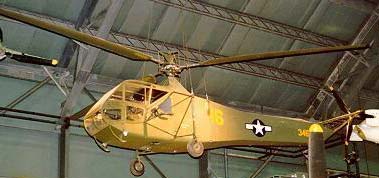
The R-6 was similar in size and configuration to the R-4 but had a streamlined fuselage, smaller supports for the main landing gear, a nose wheel as well as a tail wheel, and a more powerful engine. The rotor system and transmission were the same. Some R-6 helicopters were fitted with twin pontoons for shipboard or water operation.
Sikorsky built, the XR-6 prototype and five XR-6A helicopters, after which Nash-Kelvinator built 26 similar YR-6A variants and then 193 R-6A production aircraft under USAAF contract. (Additional production of R-6A helicopters for U.S. Navy and British use was cancelled in favor of later aircraft.)
 The Sikorsky Hoverfly was a big attraction for the GI's in WWII. This one has just landed after flying totally over the Atlantic from Roosevelt Field, LI, NY non-stop to Paris and it sure looks like those guys are stripping of souvenirs of fabric....no wait.. That was the Spirit of St Louis. sorry |
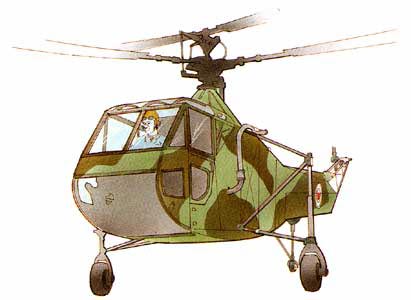 |
After many minor refinements in the design, the R-4 became the first helicopter in the world to be put into true production. Following the only XR-4 were three YR-4As, twenty-seven YR-4Bs, and 100 R-4Bs, totaling 131 produced during World War II. The importance of helicopters increased each day that R-4s were in service, demonstrating their ability to cope with tasks never before accomplished by other types of aircraft. |
 The Sikorsky XR-4 hovering at the Stratford Ct plant during its first flight. Although the photo is of poor quality, it's important because it shows the Hoverfly's initial tail configuration with a truss mounted horizontal tail rotor, virtually no fuselage covering, and and the extreme rearward mounting of the tail wheel. Photo: Steve Mizera, |
 An airman being lifted from the sea by a Dragonfly (R-4) 'Plane guard' |
 |

Specifications
(R-4B) |
 |
 |
Sikorsky R-4 helicopter.
A choice of scrap R-4 helicopters were snapped behind a hangar in this image. |



 The
three larger photos of the Sikorsky R-4 were (thank you very
much!), sent in by our cardmodelling pal, John Link, Norfolk,
Nebraska. You can see how much effort he's spent to make the
R-4 model as precise as possible. He wrote (in Mar 2001),
that he was going to build another R-4 only this time with
a full interior. The smaller photo (above) of a tiny R-4 was
sent in by modeln' pal Jim Vorwaldt
The
three larger photos of the Sikorsky R-4 were (thank you very
much!), sent in by our cardmodelling pal, John Link, Norfolk,
Nebraska. You can see how much effort he's spent to make the
R-4 model as precise as possible. He wrote (in Mar 2001),
that he was going to build another R-4 only this time with
a full interior. The smaller photo (above) of a tiny R-4 was
sent in by modeln' pal Jim Vorwaldt boom”
look of 99% of all RC heli's out there. Good for me that I found
the plans for a classic machine such as the Sikorsky R-4. It
was exactly what I was looking for: different, weird, simple
and boxy.
boom”
look of 99% of all RC heli's out there. Good for me that I found
the plans for a classic machine such as the Sikorsky R-4. It
was exactly what I was looking for: different, weird, simple
and boxy.